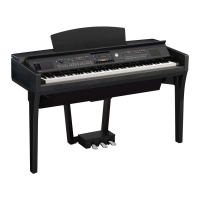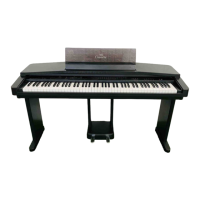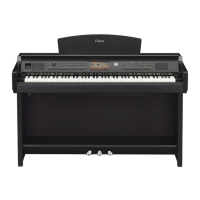Do you have a question about the Yamaha Clavinova CVP-600 and is the answer not in the manual?
Explains safety symbols and cautions indicated on the product.
General product safety, testing, and warranty information.
Critical safety warnings to prevent serious injury or death.
Important safety instructions to avoid physical injury or damage.
Instructions for proper handling, storage, and use of floppy disks.
Instructions for setting up the music stand and operating the key cover.
Steps for opening the lid, turning on the power, and connecting headphones.
Controls for overall and specific playback volume levels.
Using a five-band equalizer to fine-tune the overall sound timbre.
Introduction to the rich variety of authentic and dynamic voices.
Alternative method for selecting voices directly from the main display.
Layering two different sounds for a richer tonal texture.
Assigning different sounds to the left and right sections of the keyboard.
Explains the function and operation of the three pedals.
Enabling reverb and selecting from various reverb types.
Enabling effects and choosing from various effect types.
Introduction to the 100 musical styles for rhythm and orchestration.
Methods for choosing styles using the STYLE SELECT display.
Alternative method for selecting styles directly from the main display.
Different ways to initiate accompaniment playback.
Basic operation of the metronome, including tempo and volume adjustment.
Methods for inputting chords like Single Finger, Fingered, Multi Finger.
Simple method for inputting chords using basic rules.
Advanced chord input techniques for complex accompaniment.
Controlling volume levels for the entire accompaniment and its parts.
Accessing the mode for creating and editing custom accompaniment styles.
Storing created custom styles to disk for backup and reuse.
Importing accompaniment styles from optional Style File disks.
Handling style file disks and playing loaded styles.
Saving and recalling complete panel settings for instant recall.
Loading previously saved panel setups using registration numbers.
Introduction to playing recorded songs and disk music data.
Basic playback operations and muting individual song parts.
Choosing songs and identifying supported file formats.
Controls for initiating and terminating song playback.
Adjusting the master volume level for song playback.
Adjusting the volume of each individual track within a song.
Repeating specific phrases or entire songs for practice.
Repeating user-defined sections (Point A to Point B) of a song.
Overview of learning features: guide lamps and piano roll display.
Learning methods like Easy Play and Next Note for timing and note accuracy.
Repeating short musical phrases for focused practice.
Steps for activating and controlling the learning guide feature.
Choosing learning modes and following practice procedures.
General overview of navigating and using the function mode menu.
Preparing disks by formatting them for recording data.
Simple and fast method for recording songs.
Configuring recording settings, including mode and track selection.
Capturing keyboard performance and auto-accompaniment data.
Finalizing settings and initiating the recording process.
Comprehensive safety guidelines covering electrical, fire, and personal safety.
| Speakers | 16 cm x 2 |
|---|---|
| Keytops | Synthetic Ivory Keytops |
| Drum/SFX Kits | 29 Drum/SFX Kits |
| Effects | Reverb, Chorus, DSP |
| Songs | 50 preset |
| Display | LCD |
| Connectivity | MIDI In/Out, Headphone, Aux In/Out |
| Voices | 480 |












